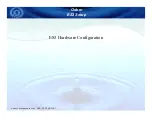
If the cassette is out of date, it is rejected and the control subsystem
presents an appropriate message on the front panel LCD. If the cassette
is accepted, it is advanced into the unit to position the next available cell
at the injection aperture. A signal is transmitted to inform the control
subsystem that a good cell is available for the next cycle.
A pneumatically driven clamping mechanism presses the cassette down
onto a needle which punctures the hydrogen peroxide cell. Air pressure
applied through the clamp collapses the cell and forces the hydrogen
peroxide into the injector valve.
The injector valve pierces and connects the cell to the chamber through
a pressure relief valve that provides the vacuum seal. The valve
incorporates a chamber and heater to vaporize the H
2
O
2
and deliver the
vapor to the chamber.
A few seconds into the diffusion cycle, the cassette is indexed to the next
usable cell. If that cell is found to be the last on the cassette, the control
system displays a related message on the front panel LCD at the end of
the cycle. If the last cell has been used, the cassette is ejected towards
the rear of the injector pump subsystem and, as the next cassette is
inserted, the used cassette falls into the cassette collector box.
The cassette collector box holds 30 used cassettes. When the box is full,
the front panel displays a message informing the operator that the
cassette collector box must be replaced before another sterilization cycle
can begin.
Cassettes
The hydrogen peroxide is contained in a disposable cassette. Each
cassette has ten cells containing premeasured, concentrated hydrogen
peroxide.
WARNING! Disposable cassettes contain concentrated (58%)
hydrogen peroxide which is a powerful oxidizer and
irritant. Do not remove the plastic wrap from the
cassette if the chemical indicator on the cassette
box has turned red. IF THE INDICATOR IS RED, THE
CASSETTE HAS BEEN DAMAGED. Return all
damaged cassettes, unopened, to ASP Customer
Support.
An inserted cassette is pressed under a roller and sensed by the cassette
sensor (a reflective optical device) and advanced to read the bar-code. If
the bar-code, as read by the cassette sensor, indicates a valid cassette,
the cassette is advanced, and the first of the ten positioning marks on
the side of the cassette is moved past the sensor.
Each cassette carries coded information printed on the right side of the
cassette shell. On the lower half of the shell is bar-coded date of
manufacture (month, year) and cassette application information with a
parity bit. On the upper half is printed the lot code and date of
expiration in Arabic numerals. Decoded bar-code information is not
needed in the field.
Theory of Operation-Injection Subsystem
Injection Subsystem
ASP Service Guide rev D
STERRAD® 100 Sterilizer
5-3
Содержание STERRAD 100
Страница 284: ......
Страница 285: ......
Страница 286: ......
Страница 287: ......
Страница 288: ......
Страница 289: ......
Страница 290: ......
Страница 291: ......
Страница 292: ......
Страница 293: ......
Страница 294: ......
Страница 295: ......
Страница 296: ......
Страница 297: ......
Страница 298: ......
Страница 299: ......
Страница 300: ......
Страница 301: ......
Страница 302: ......
Страница 303: ......
Страница 304: ......
Страница 305: ......
Страница 306: ......
Страница 307: ......
Страница 308: ......
Страница 309: ......
















































